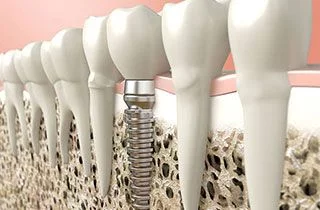If you lose your tooth, you need a dental implant to get your smile back. The first implants were manufactured around 30 years ago. But which materials are good for dental implants? In the old days, the primary aim was to replace missing teeth so looks were not so important. Later, however, the aesthetic benefits played an important role. Here you will find information about the dental implant materials
This article will answer the following questions:

- The structure of the implant
- The material of the implant
- Dental implant materials – Titanium
- Dental implant materials – Ceramic
- Dental implant materials: titanium or ceramic?
The structure of the implant
The dental implant is not a one-piece unit, but consists of three main parts. One is the artificial tooth root that is embedded in the jawbone, the other is the abutment, and the third one is the crown that goes around it. Of the three elements, the crown is what is visible from the outside, so this should closely resemble healthy teeth.
The material of the implant
After implantation, the implant becomes a permanent, “inseparable” part of the human body, penetrating the gums. It is not difficult to recognize that the most stringent requirement for the implant material is to be tissue friendly. More specifically, this means that the body can absorb it without causing any damage, and the bone and gums can grow on it without gaps.
Much of the artificial tooth root is made of pure, unalloyed titanium. Titanium is common in surgery because this metal does not cause any allergic reactions. Another advantage of it is that it fits extremely well into the jaw, so there is no reason for being afraid of rejection.
The crown part of a denture can be made of several materials; professionals usually use ceramics or noble metals.
Let’s take a closer look at the main properties of the materials that make up an implant.
Dental implant materials – Titanium
Dentists have been using titanium implants for many years to successfully replace missing teeth. Titanium does not trigger any reaction in the body and is generally tolerated. However, it may be contaminated with small amounts of nickel and pewter, which can lead to “titanium incompatibility” in some patients.
Prior to insertion, the dentist roughens the surface of the implant chemically or manually. This facilitates the bonding between the implant and the bone so the implant grows better together with the jawbone.
Dental implant materials – Ceramic
Ceramic has been used in medicine since the eighties. Today, implants made of zirconium oxide (ceramic) stand as an alternative to titanium dental implants. The main feature of this material is its natural color. A ceramic implant can both fulfill the role of a natural tooth, and meets the high aesthetic demands thanks to its white colour.
Ceramic is a tissue-friendly and biocompatible material. In contrast to metal, it does not trigger intolerances in the body or with any other metals.
While they do not cause intolerances, the implants made of ceramic can have other medical disadvantages. Even with the insulating effect of ceramic, bacteria can attack the gums and cause gingivitis around the dental implant.
Dental implant materials: titanium or ceramic?
Dental implantology only uses these two materials. They both have the advantage of durability, being both very strong materials. Also, the human body tolerates both of them, although a small percentage of people can be allergic to metals. Despite of metal-intolerance, the use of titanium is much more frequent for implants worldwide. Titanium and ceramic differ only in their aesthetic appearance and of course in their costs.
Picture: Ne¾a Èerin
In reality, however, not the implant material is the decisive aspect while choosing between dental implantation systems, but the process by which the surface of the materials is treated.


